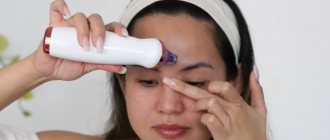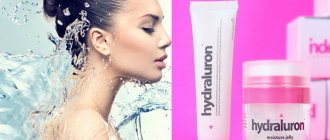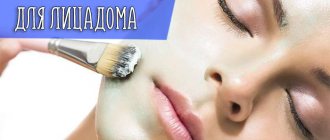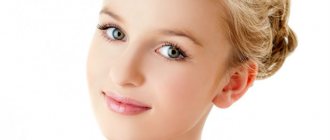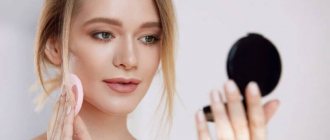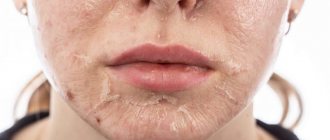Frequency of chemical peels
Many women prefer chemical exfoliation due to the variety of its types, purpose and speed of solving aesthetic problems. Acid and enzyme compositions of the required concentration allow you to exfoliate the skin at a certain depth, thereby correcting not only minor defects in appearance (for example, facial folds or acne), but also reducing serious age-related changes, hyperpigmentation and rosacea. Let's find out how often to do chemical peeling of the face in the case of superficial, medium and deep techniques.
Superficial peeling. Such acid or enzyme exfoliation “dissolves” only the top layer of the epidermis. Most often, surface manipulations are performed using fruit, glycolic and lactic acids, as well as enzymes and peptides. The purpose of superficial peelings is to combat mimic and first age-related skin changes and signs of photoaging.
A course of superficial peelings consists of 5-8 sessions, with a mandatory break between them of 10 to 14 days. The interval between courses is 4-6 months.
Medium peeling. In addition to correcting minor imperfections in appearance, mid-face cleansing helps prolong youth, get rid of hyperpigmentation, bumpiness after acne, and inflammatory processes. For medium peels, more concentrated acid preparations are used, which are washed off with neutralizers. This type of exfoliation is dangerous to perform at home; it is better to trust a professional. As a result of medium peels, acid molecules can penetrate to the granular layer of the dermis, so chemical burns must be controlled. Frequent use of TCA peels, retinoic peels, azelaic, phytin, pyruvic and their analogues leads to complications.
It is necessary that the course of medium peels consist of no more than 3-4 sessions with a break of 2 weeks. Such exfoliation is carried out only once a year in autumn or winter.
Deep peeling. This is a serious exfoliation that can only be performed in a beauty salon. The destruction of the entire layer of the epidermis and the initial layer of the dermis occurs with the help of toxic phenolic acid. Deep peeling is only suitable for mature skin or skin with scars and scars.
A course of deep phenol peeling consists of 1 procedure, which must be repeated no more than once a year and only in the autumn-winter season. Only 3 sessions of deep exfoliation are allowed in your entire life.
Only a professional cosmetologist can choose the correct frequency of peelings for a woman. After all, rare exfoliation will not bring results, and frequent exfoliation is dangerous with the risk of side effects.
Chemical method
This method involves the use of active substances. If we are talking about home peeling, then you should use natural products or ready-made cosmetics that contain acids.
The procedure begins with cleansing the face of makeup and impurities. You can use milk, micellar water or cleansing gel. Apply the composition to the entire face, except for the area around the eyes. If you purchased the product at a pharmacy, you should keep it for no more than five minutes. Self-made products from berries or kefir can be left on the face for up to 30 minutes. The mass is washed off with warm water. Next you should use a moisturizer.
Speaking about how to use facial peeling, it should be noted that the procedure with acids is carried out no more than once every 10 days.
If the event was held at home, then there is no need to adhere to any special recovery measures. But you should remember that immediately after the procedure you should not visit saunas, solariums or be exposed to open sunlight.
Before choosing a peeling product, you need to consult a doctor. He will examine the skin and select the most suitable composition for the procedure.
Glycolic peeling
Glycolic Acid is perhaps the most popular and best known among alpha hydroxy acids.
Firstly, glycolic acid has a small molecule size, it is very tiny - only 76 Daltons, thanks to which it penetrates the skin easily and deeply.
Secondly, glycolic peels have a wide spectrum of action:
- even out the relief, make the skin smooth,
- stimulate the synthesis of collagen and hyaluronic acid, which helps increase skin elasticity and smooth out wrinkles,
- reduce sebum secretion,
- help cleanse pores and eliminate blackheads.
Thanks to such versatile properties, peelings with glycolic acid can be used to solve aesthetic problems of both aged and young skin.
However... Despite their wonderful properties, glycolic peels are not suitable for everyone. For those with sensitive skin with rosacea and couperose, glycolic acid can cause severe redness, prolonged inflammation and excessive flaking.
As a result, instead of the listed positive effects, owners of such skin may experience persistent redness, dehydration, hypersensitivity and more pronounced rosacea.
Therefore, I advise such people to pay attention to the following two acids
Brave ladies of antiquity used a brutal mixture consisting of olive oil and fine sand as a peeling agent. Thank the cosmetic gods, those days are gone, and we have products softer than sand, but we are fighting, as then, for the same prize - unfading youth.
Peeling is such a popular remedy that only the lazy, it seems, have not come up with their own way of exfoliating dead skin particles.
Each brand has two or three patented peeling compositions. Who cares? A couple of years ago, one extremely respected brand shocked the world community with a peeling in which tiny grains (according to science, called nuts) covering strawberries were used as exfoliating elements. It’s scary to imagine how many kilos of strawberries you need to lime to get one tube of this peeling, and the price for it was, of course, appropriate. In general, not everyone can understand this crazy variety of peelings. While, in fact, to choose a peeling, you just need to be guided by the principle of age. So, how old are you? -20-30 years
During this period, the skin, and you along with it, have a happy time.
There are no special needs or requirements - she still retains elasticity on her own, but bad manners are already beginning to make themselves felt. The optimal renewal regime for the skin is 28 days. In adolescence, she copes with this task on her own, but, crossing the landmark mark of 20 (for some, 25 for others), she begins to not fit into the rhythm. Gradually, the process of cell replacement and renewal becomes slower. And now it’s time to peel for the first time. Cosmetic peeling For twenty-year-olds, the simplest, gentlest type of peeling is addressed – the so-called cosmetic peeling. This is exactly the kind of peeling that many people do at home. Compositions with small exfoliating particles, salt, crushed apricot kernels or any other are part of the arsenal of cosmetic peelings. This is a preventative measure that helps the skin renew itself. Cosmetic peeling copes with the task of superficial, I would even say, symbolic exfoliation. Effective in cases of mild acne. But nothing more. It can be used as an additional measure at any age, but as a main one - only up to twenty-five. For those who are a little older, it’s time to learn more serious types of peeling. For example, glycolic. Glycol peeling This is a universal procedure and belongs to the category of superficial chemical peels. The active ingredient here is glycolic acid. Depending on your age, its concentration will be different. For young people, as a rule, they choose a 25% solution, and the older you are, the higher the concentration will be. In addition, the cosmetologist, when preparing the composition for you, also takes into account the sensitivity of the skin. Glycolic peeling not only eliminates dead skin particles, but as a bonus it also stimulates the activity of collagen-producing cells - fibroblasts. Therefore, this type of peeling can be regarded not only as a means of enhancing complexion, but also as a measure to combat the first wrinkles. In low concentrations, glycolic peeling can be done several times a month. Glycolic peeling should not be painful. A slight tingling and burning sensation is acceptable. Two to three days after the procedure, slight peeling of the skin may appear; moisturizing creams are the counteraction. In general, the principle of any peeling is to remove dead skin particles, thereby disturbing its calmness and forcing it to generate new cells - thanks to this, after peeling our skin looks fresh and “new”. Therefore, you should not be afraid of temporary peeling: after it, a “second life” will come to your skin. - 30-40 years old
At this moment, the skin becomes less elastic, collagen and elastin - the framework responsible for how toned the face looks - are no longer produced in sufficient quantities.
In addition, the activity of the sebaceous glands decreases, and therefore the skin becomes drier than before. Wrinkles around the eyes and on the forehead become noticeable, and the nasolabial fold is clearly visible. And if in twenty-year-olds the skin is renewed in the fast paso doble dance mode, then in thirty or forty it switches to the waltz. The optimal type of peeling for this age is retinoic peeling, also known as the famous yellow peeling. Yellow peeling
Peeling consists of several acids: azelaic, kojic, phytic and ascorbic, each of which enhances the effect of the other.
But its main component is retinoic acid. It is this that causes a slightly yellowish color to the skin during the first two days after the procedure. Its effect on the skin is quite mild, but still stronger than that of glycolic. This is the kind of peeling that requires rehabilitation, albeit short-lived. It will take two days to a week for the skin to feel comfortable. Typically, yellow peeling is done no more than twice a year. The effect is the elimination of emerging facial wrinkles. -40-50 years old
At this age, the derama - the connective tissue of the skin - becomes thinner.
Facial folds are now especially noticeable, pigmentation becomes uneven. The skin renews itself extremely slowly. A capillary network and circles under the eyes appear. At forty-five - Baba Berry again. Who would argue. We are fighting with all our might for the title of “berry,” and laser peeling is ready to help us with this. Laser peeling
For this type of peeling, or skin resurfacing, two types of laser beams are used.
Erbium rays are capable of penetrating a short distance, while carbon dioxide rays can penetrate a greater distance. The cosmetologist chooses one or another type of laser depending on the sensitivity of the skin. Having passed the laser over the face or neck, the cosmetologist will literally “evaporate” the upper layers of the skin, after which it will be completely renewed. This laser treatment does not cause pain, but the rehabilitation period, during which the reddened skin will return to its natural state, will take about ten days. The result of the procedure will not be visible immediately: the face will look its best after three or even six months. -50 years and older The oval of the face loses its contour. This, no matter how trivial it may seem, is due to the force of gravity. The cheeks and chin sag, no matter how sad it sounds. The eyebrow line decreases. But having formulated the problem, we know what we need to fight. Phenol peeling
A radical measure to combat serious wrinkles is phenol peeling.
This procedure is quite traumatic and requires anesthesia, but at the same time, incredibly effective. Rehabilitation takes more than a week, but at the same time this type of peeling provokes a total renewal of the skin. This procedure has contraindications: kidney, liver and heart diseases. The fact is that the main component of the skin-renewing composition is phenol. The substance is toxic, causing death in high doses. You'll read a lot of horror stories about this type of peeling on the Internet, but it's all about the dose. A competent cosmetologist will select the right one, and in this case you will not have to regret the procedure. The effect of such peeling lasts for several years. Microdermabrasion
Refers to the list of radical measures.
The procedure is as follows: the device delivers tiny particles of aluminum oxide to the skin through special tubes at high speed. Like sandpaper, they polish the face. The rehabilitation period is minimal; within one day the skin returns to normal.
One procedure or a whole course - which is better?
In the modern world of cosmetology, peeling is considered a mandatory procedure in skin care. It guarantees not only deep cleansing of the skin, removal of dead, non-working epidermal cells, but also activates a number of important processes inside the integument, revitalizes them and accelerates the synthesis of natural collagen. After cleansing, the face looks much younger, the skin becomes lighter, a slight blush appears and a lifting effect is observed.
Facial peeling is carried out in courses or one-time, depending on the type of procedure, depth of impact, as well as the expected result.
If cleaning is performed to prevent early withering of the integument, one procedure is allowed. But in this case, cosmetologists recommend carrying them out regularly, with an interval of 1–6 months, depending on the chosen cleansing method.
To correct visible imperfections on the face, get rid of acne, and excessive oiliness, cosmetologists recommend a course of peeling. A one-time cleaning of the integument will not provide the desired result if we are not talking about a deep impact.
Ideally, a full course of procedures is carried out to eliminate the skin problem, and then superficial, one-time cleansing is expected to maintain the achieved effect and prevent deterioration of the skin's condition.
Suitable time for the procedure
The time of year plays an important role in choosing when to peel. Winter time is the most suitable time for peeling sessions. The climate in winter is most favorable for the skin. Cold has a beneficial effect on the tone of the skin and its saturation with oxygen, heat does not provoke the spread of acne and pimples, ultraviolet radiation does not have an effect in the form of the appearance and growth of age spots and irritations.
In winter, you can tidy up your appearance in a matter of days with the help of AHA acid. This will help cleanse and tighten pores for clients with increased oily skin. Already by the spring sun, the skin will be clean, natural and renewed.
When you can peel depends on your circumstances and personal needs. It should be taken into account that summer brings many negative factors that can nullify the results of the procedure.
Peeling combats the signs of photoaging, the effects of heat, cold, and toxic substances. Peeling removes damaged and contaminated layers of the epidermis, improves cellular respiration, promotes the regeneration process, improves complexion and overall skin condition.
If you need to perform the procedure in the heat, it is better to follow the recommendations:
- the skin should be constantly moisturized;
- It is better to avoid a set of measures if the skin is irritated, which, together with the heat, leads to undesirable consequences - allergies;
- After completing the procedure, you need to avoid direct sunlight and use ultraviolet protection;
- Having completed the procedure, it is not advisable to visit the sauna or any bathhouse, and it is better to avoid active sports.
In hot weather, the effect of the session is much worse than in cold weather.
It is better to apply a set of skin cleansing measures in the evening so that the skin can rest. This will provide the best effect.
Types of rollers and features of their use
Now there are a large number of facial exfoliations to choose the perfect roll. They are distinguished:
- By content (acids, fruit enzymes, egg white);
- Consistency (cream, gel, liquid);
- To the manufacturer;
- Depends on the skin (they are mostly universal).
There are moisturizing (Nu Skin Polishing Peel), soothing (librederm Hebral Care), anti-inflammatory (Tony Moly Peeling Me Aqua Moisture), for color (Secret Key Lemon Srarkling), anti-aging (Deoproce Green Tea).
Korea is known for its natural facial products.
Top 10 peeling rolls from Korea:
- A'PIEU Naked Peeling Gel Diamond;
- Mizon Apple Smoothie Peeling;
- Skinfood Pineapple Peeling;
- Holika Gudetama Smooth Egg Skin;
- Echoice with fermented soybean extract;
- A'pieu with apple;
- Advanced B5 Hydratio;
- Tony Moly Appletox Smooth;
- SUPER AQUA Oxygen;
- Mangowhite peeling gel.
Usage reminder:
- Before applying the product, you need to cleanse your face and steam it.
- After application, the mask is massaged, removing pellets from dead skin.
- After the procedure, if you need to go outside, apply cream.
- You cannot immediately use a towel after exfoliation, otherwise the epidermis will be damaged.
- The mask is not applied around the eyes and lips.
- In case of severe burning and itching, everything is quickly washed off.
With calcium chloride
You will need calcium chloride 5% and baby cream or soap.
- Lather your face with soap or apply a layer of cream.
- Calcium chloride is then applied using a cotton swab.
- Wash off the mask when lumps begin to appear.
- Moisturize your skin.
With a creamy consistency
The face cream roller is easy to use. It performs an abrasive function, giving a healthy shine. It also delicately cleanses the skin without causing irritation or inflammation. The skin will be silky and elastic, oxygen and nutrients are better supplied to the epidermis.
The cream has a moisturizing property, which then makes the use of cosmetics effective. It also has a restorative effect and controls sebum secretion.
Its use is convenient: apply the consistency and massage lightly. Then rinse with water and apply a moisturizing mask.
Bubble Cleaning Rolls
Bubble rolling for the face is one of the pleasant procedures. This is an unusual product for gentle skin cleansing. Its texture consists of thousands of bubbles that are filled with oxygen, which is necessary for the epidermis.
Before applying the mask, moisturize the skin. Gradually, the foam turns into a gel, which forms pellets, removing impurities and dead skin. Also, unlike other peels, it can be applied simply with clean hands.
The face roll moisturizes and soothes the skin if it contains herbal ingredients and tea tree oil. The gel copes well with various inflammatory processes and slows down the elimination thanks to antioxidants.
Contraindications and advice from a cosmetologist
Peelings are indispensable in quality facial skin care. This is the minimum that should be carried out by every woman, and according to indications - by men.
Contraindications must be taken into account:
- skin diseases;
- autoimmune diseases;
- allergic and hypersensitive skin;
- Peeling should not be carried out if the body is weakened by bacteria or viruses.
Recommendations from cosmetologists for those who have undergone the procedure:
- It is prohibited, until complete recovery, to visit saunas, baths, and solariums. Sunbathing in spring and summer is strictly prohibited.
- Do not touch your face with your hands to avoid tissue infection. Use only medicinal and moisturizing sprays recommended by your cosmetologist.
- Do not use decorative cosmetics until tissue regeneration is complete.
- Be sure to use sun protection when going outside.
- Do not tear off the crusts on your face with your hands. The process must go through all stages of healing on its own. Otherwise, scars will form on the face.
- If there is the slightest suspicious change or suppuration on the face, immediately contact your cosmetologist.
Follow all the recommendations of a professional specialist, and the result of the procedure will please you for a long time.
What you need to know about the frequency of procedures
Joshua Zeichner, a dermatologist in New York City, says the question of how often to exfoliate your face remains a fundamental one. If you try too hard, the skin becomes inflamed, then peeling occurs, and the affected areas often increase in size. Zeichner's colleague, dermatologist Ranella Hirsch, says frequent exfoliation is the main reason clients complain of breakouts. What do you need to know about the procedure before you get started?
- Even if you use gentle products 3 times a week, you risk damaging your skin's health. Due to constant exposure, microcracks form on the top layer, which leads to loss of moisture and inflammation.
- Carry out the procedure carefully, because excessive friction is fraught with microtrauma. Ranella Hirsch admits: “For a mysterious reason, people believe that to exfoliate you need to treat the skin so roughly, as if they are trying to torture it to extract secret information from it. Many people use scrubs for mechanical cleansing, and then immediately turn to chemicals. But, although these products will be beneficial individually, they cannot be used together.”
- How often can you exfoliate your face at home if you have very oily skin? Instead of increasing the frequency of treatments, use alternative methods. You will need a cleansing product with salicylic acid, since it will effectively remove clogged pores.
- The use of hydroxy acids allows you to remove a layer of dead cells and smooth out wrinkles. In cosmetology, glycolic, lactic, malic, and tartaric acid are used. But the use of products requires additional measures: even in winter, the skin will become more sensitive to ultraviolet radiation, and the application of a protective cream will be mandatory.
- Don’t approach the process formally, because your skin will tell you how often you need to exfoliate your face. Ranella Hirsch urges: “Don't exfoliate just because you've reached the required number of days. Focus on the condition of the covers.”
Take into account the subtleties, and you will be pleased with the result.
Peeling frequency depending on the depth of exposure
Peels are distinguished by the degree of impact on the skin. Let's take a closer look at the nuances of each of them:
Surface
The easiest and most gentle type of this type of cleaning. The chemical does not penetrate deep into the skin and does not affect living cells. Most often, fruit or lactic acid is used. The solution has a small (up to 20%) concentration percentage, which explains the surface effect.
Mechanical superficial peeling is also possible, based on manual cleaning of the stratum corneum.
It can be performed once before a course of deeper effects to pre-clean the skin. If we talk about an independent procedure, it is recommended to take a course of 4–10 sessions.
The break between procedures is from 1 to 1.5 weeks. The duration of the course depends on the problem: getting rid of pigmentation, anti-aging effect or acne treatment.
Depending on your skin type and sensitivity, your face may turn red after the procedure, and after a couple of days it may peel. This is a natural phenomenon, you just need to use moisturizing creams more often and give up decorative cosmetics for a while.
Median
It affects the entire depth of the epidermis when a deeper effect on the problem is needed. These may be signs of photoaging, medium and deep wrinkles, as well as age spots and moles on the face. The procedure is performed for women over 25 years of age. The chemical medium peeling agent is trichloroacetic acid with a rate of 20-50%. Hardware peeling is possible.
After treatment, the skin receives a slight burn; recovery after each procedure lasts 2 weeks. The course, depending on the problem, ranges from 3 to 10 sessions.
Deep
The impact is carried out on the entire depth of the epidermis and half of the layers of the dermis. The deep type is used extremely rarely due to the aggressiveness of the impact and the very long recovery period. This type includes hardware, mechanical and chemical peels.
Of course, the client receives a powerful aesthetic rejuvenating effect, but the procedure itself is painful and requires patience and great care in the post-peeling period.
Cosmetologists recommend using deep treatments as a last resort (for example, to get rid of a scar). The frequency of repetition of the procedure is at least a year.
Note! The more aggressive the peeling, the longer the skin recovers after the procedure. But there is also a positive nuance - the rejuvenation effect occurs faster and lasts longer.
Preparations for the procedure
Chemical peeling of the facial skin is carried out with acids. They affect the surface with different intensities:
Products based on hydroxy acids. These are all fruity and glycolic, providing a gentle effect on the skin. They belong to the category of alpha hydroxy acids. Fruit and glycolic peelings help nourish the skin with moisture, so they are more suitable for extreme dryness. Beta-hydroxy acids also belong to this group.
These substances penetrate deeper into the skin, therefore they are able to regulate the functioning of the sebaceous glands, more energetically stimulate the rejuvenating processes in it, and cleanse it carefully but efficiently. The most commonly used drug is salicylic acid. Alpha and beta hydroxy acids are found in the preparations Jan Marini, MD Forte, Cosmedix, Agera RX, LA Peel.
- Products whose main component is trichloroacetic acid. It comes in different concentrations, so there are preparations for medium and deep peels. In the first case, 25 - 30% substance is used. For a deep effect, a concentration of 40% is required. This series includes the drugs “Skintech Peel”, “Compositum”, “Obagi Blue Peel”, “Cosmedix”.
- Products with retinoic acid. Designed for so-called yellow peeling. The preparations also contain ascorbic, phytic, azelaic acids, and vitamin C. In beauty salons they use Mediderma products.
- Products containing phenol (carbolic acid). They also come in different concentrations, so they are used for medium or deep effects. These are drugs “MC Peel”, “Green mask”, etc.
Features of the procedure
This is a cosmetic procedure in which the top layer of the epidermis is exfoliated. Only dead keratinized particles are removed, which prevent access to the microelements necessary for the skin. The effect of the procedure stimulates the natural processes of the body - cell renewal, acceleration of microcirculation.
Many women wonder whether it is possible to exfoliate every day if it has such a positive effect on the skin. Daily use can be harmful to the skin, since it will not be dead particles that are removed, but the epithelial barrier necessary for protection.
There are several types of procedures, based on the compositions used and methods of influence. A wide variety of types allows you to choose the optimal cleansing method for each skin type.
When to exfoliate
Before doing such a procedure, you need to find out the indications and contraindications for glycolic peeling. Indications for the use of this procedure:
- peeling, the appearance of traces of dryness (peeling with a lower acid concentration is used);
- poor skin color, redness (a superficial type of peeling is also used);
- acne, spots, marks from squeezing them out (only deep, acid peeling will help here);
- stretch marks on the face (both the 1st and 2nd types of procedures are used);
- oily skin (when cosmetic manipulations do not help, use a superficial type of peeling);
- wrinkles (deep folds can be removed only with chemical solutions, all others can be removed using regular face cream, solutions based on aloe, fruit acid);
- freckles and age spots.
Glycolic facial peeling is prescribed only by a cosmetologist as it can only be used in compliance with all safety rules. He also determines the number of procedures, depending on the type of redness, the causes of wrinkles and spots. The main thing is not to overdo it, as this type of peeling in large quantities can harm the health of the skin.
Chemical peeling of the face also has a number of contraindications:
- It is not advisable to do the procedure in the warm season, in spring or summer; it is best done in winter, when there is no harsh exposure to sunlight;
- Pregnant women and young nursing mothers should also not undergo chemical peeling (too high acid concentration can harm the baby);
- The procedure is prohibited for people with a variety of skin diseases and neoplasms, such as herpes, seborrhea, lichen, and also when there are warts on the face;
- if a person plans to sunbathe for a long time in the sun, be exposed to ultraviolet radiation for a long time;
- people who have dark skin, black or brown eyes, dark hair (the peeling area may be too different from the color and type of skin);
- if there are various scratches, wounds, or other damage on the face (you need to wait until they heal);
- if you want to do peeling, you have inflammation on your facial skin;
- patient intolerance to some peeling components;
- the procedure is contraindicated for people suffering from rosacea (severe redness of the face);
- The procedure is contraindicated for people who have recently undergone hormonal therapy or a course of chemotherapy.
Many patients ask the question: how many procedures should be done to get the maximum effect? Superficial glycolic peeling can be done as much as you like, it is not harmful to health. But in order to carry out professional, deep chemical peeling without complications and consequences, you must definitely consult with a cosmetologist. The specialist himself will prescribe the required number of procedures, tell the time of implementation, and prescribe the level of glycol concentration.
How often can you do a facial peel?
The frequency of the procedure depends on the skin type and the method used. When contacting a cosmetologist, the specialist will prescribe the correct course and the appropriate number of procedures. For independent mechanical cleansing with gentle scrubs, you can adhere to the following frequency:
- For dry skin, courses are suitable for 6 procedures - once every 14 days.
- For combined – weekly for one month.
- For normal – after 4 days for 1.5 months.
- For oily people – 2 times a week for one month.
What is it for: the essence of the cosmetic procedure
Human skin is a complex system that performs several important functions and consists of small particles.
It deteriorates over time and due to other significant factors, for example, poor ecology or an unhealthy lifestyle. It becomes rough, and its top layer begins to die off.
Cells found in the epidermis are capable of regeneration, but this takes a long time. To shorten this period, peeling comes to the rescue.
Translated from English, this word (peel) means “to scrape hard . The procedure is aimed at exfoliating the keratinized (i.e., hardened, “old”) layer of the skin using masks, scrubs, and other cosmetics.
The cells that are under this layer start the renewal process. The face looks fresher and younger, and the skin itself acquires a lighter shade.
This helps fight freckles, wrinkles, scars, and acne.
A cosmetologist will tell you what peeling is and why it is needed:
Stages of facial peeling in a beauty salon
Each salon has its own distinctive stages of exfoliation. The procedure diagram everywhere consists of the following steps:
- Steaming.
- Application of the drug.
- Providing anesthesia if necessary.
- Use of special equipment in case of hardware type of peeling.
- Removal of applied drug residues.
- Treatment with an anesthetic or sedative.
- In case of deep impact , apply a bandage or a restorative mask.
- Compliance with the rules of the rehabilitation period.
An example of a session is presented in video materials from many beauty salons.
When is the best time to do a facial peel?
Traditionally, the best period is the autumn and winter seasons. At this time of year, ultraviolet activity is minimal.
Reviews from real people about facial peeling from cosmetologists
Anna, 25 years old:
From a young age I suffer from acne and acne. I tried different treatment options: acid and almond peels did not help. For dry, sensitive skin, the cosmetologist advised a course of procedure - gommage. Finally managed to solve all the problems. I recommend!
Olga, 31 years old:
For girls with facial skin problems after the age of 25, I advise you to try the hyaluranium method. The effect is noticeable immediately, the procedure does not cause discomfort. In the salon, to consolidate the result, 5 sessions were carried out. It was possible to whiten my face, remove freckles and the effects of acne. Thanks to the specialists!
Antonina, 57 years old:
Good day. After 50 years, age-related changes began to be noticeable on the skin, and even professional creams could not cope with the problems. Thanks to deep chemical peeling and the work of specialists, it was possible to significantly rejuvenate the face.
Natalya Podolskaya, 30 years old
I recommend that all girls with skin aging problems sign up for a needle peeling session. The cosmetologist’s work lasts no more than 30 minutes; after a couple of days, the face looks several years younger. I’m happy with the result, I didn’t find any cons for myself!
Facial care after laser peeling
Post-procedural regime, i.e. Facial care after laser peeling cannot be ignored. The rehabilitation period and the final result depend on this.
At first, for 3 days, it is better not to leave the house. If such a need arises, be sure to apply sunscreen and avoid sunny places. During this entire period, all alcohol-containing cosmetics are strictly prohibited.
For a week after peeling, it is not recommended to visit baths, swimming pools, saunas, or beaches. You should also refrain from playing sports.
All 10 days after the procedure, the skin needs careful care. To avoid dryness and a feeling of tightness, the cosmetologist will recommend a special moisturizer. It should be applied regularly to the skin of the face. You should also not sunbathe or visit a solarium for 10-15 days.
WHEN IS IT BETTER TO START?
Along with puberty, global hormonal changes begin, and tissues “work” differently. The sebaceous glands become more active, the pores quickly become clogged, which provokes the appearance of numerous pimples and blackheads. The face needs cleansing, but during adolescence only gentle cleansing is recommended.
Suitable for teenagers:
- Scrubbing;
- Film masks;
- Ultrasonic cleaning.
At this time, it is worth focusing on natural products for gentle and superficial scrubbing. Compositions for young skin will remove dead layers of the epidermis and remove atmospheric pollution, provide normal nutrition and hydration.
After 30 years , muscle tone decreases, and the sebaceous glands begin to work unstably - secretion secretion slows down. The skin loses moisture faster, and due to impaired blood flow, the complexion gradually changes. Collagen is produced in smaller quantities, and the face may lose its elasticity.
During this period, more aggressive types of peeling are allowed, including chemical peeling. The procedures will make the face younger, even out the tone, and smooth out facial wrinkles.
After 40-45 years, experts recommend deep exfoliation and laser resurfacing to restore youth.
Preparation for the procedure
For such a serious procedure as laser peeling, you need to properly prepare. This stage should not be neglected, because the final result depends on this.
You will have to take care of preparations already 2 weeks in advance. From this period it is better to stop going to the solarium or to the beach. You should not start taking antibiotics and it is better to avoid facial cleansing and chemical peels. It is forbidden to scrub your face at home.
